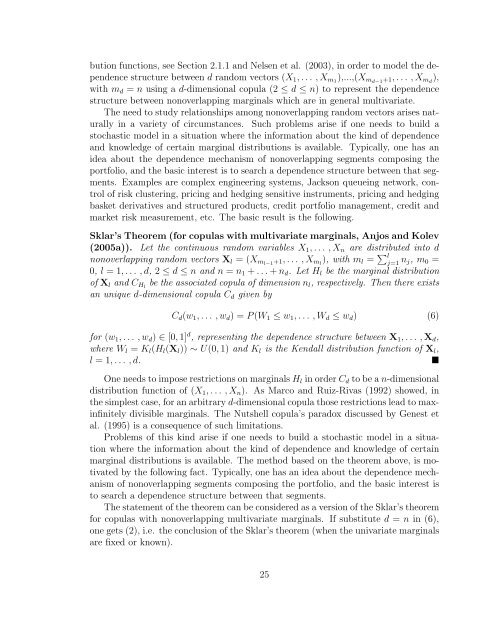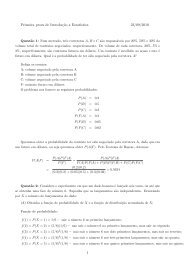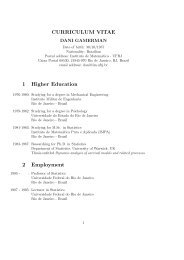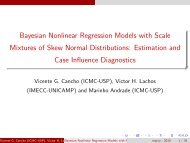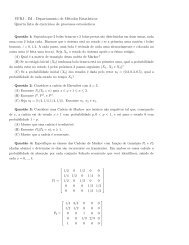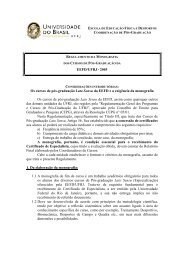Copulas: a Review and Recent Developments (2007)
Copulas: a Review and Recent Developments (2007)
Copulas: a Review and Recent Developments (2007)
You also want an ePaper? Increase the reach of your titles
YUMPU automatically turns print PDFs into web optimized ePapers that Google loves.
ution functions, see Section 2.1.1 <strong>and</strong> Nelsen et al. (2003), in order to model the dependencestructure between d r<strong>and</strong>om vectors (X 1 ;::: ;X m1 ),...,(X md¡1 +1;::: ;X md ),with m d = n using a d-dimensional copula (2 · d · n) to represent the dependencestructure between nonoverlapping marginals which are in general multivariate.The need to study relationships among nonoverlapping r<strong>and</strong>om vectors arises naturallyin a variety of circumstances. Such problems arise if one needs to build astochastic model in a situation where the information about the kind of dependence<strong>and</strong> knowledge of certain marginal distributions is available. Typically, one has anidea about the dependence mechanism of nonoverlapping segments composing theportfolio, <strong>and</strong> the basic interest is to search a dependence structure between that segments.Examples are complex engineering systems, Jackson queueing network, controlof risk clustering, pricing <strong>and</strong> hedging sensitive instruments, pricing <strong>and</strong> hedgingbasket derivatives <strong>and</strong> structured products, credit portfolio management, credit <strong>and</strong>market risk measurement, etc. The basic result is the following.Sklar's Theorem (for copulas with multivariate marginals, Anjos <strong>and</strong> Kolev(2005a)). Let the continuous r<strong>and</strong>om variables X 1 ;::: ;X n are distributed into dnonoverlapping r<strong>and</strong>om vectors X l =(X ml¡1 +1;::: ;X ml ),withm l = P lj=1 n j, m 0 =0, l =1;::: ;d, 2 · d · n <strong>and</strong> n = n 1 + :::+ n d .LetH l be the marginal distributionof X l <strong>and</strong> C Hl be the associated copula of dimension n l , respectively. Then there existsan unique d-dimensional copula C d given byC d (w 1 ;::: ;w d )=P (W 1 · w 1 ;::: ;W d · w d ) (6)for (w 1 ;::: ;w d ) 2 [0; 1] d , representing the dependence structure between X 1 ;::: ;X d ,where W l = K l (H l (X l )) » U(0; 1) <strong>and</strong> K l is the Kendall distribution function of X l ,l =1;::: ;d. ¥One needs to impose restrictions on marginals H l in order C d to be a n-dimensionaldistribution function of (X 1 ;::: ;X n ). As Marco <strong>and</strong> Ruiz-Rivas (1992) showed, inthe simplest case, for an arbitrary d-dimensional copula those restrictions lead to maxin¯nitelydivisible marginals. The Nutshell copula's paradox discussed by Genest etal. (1995) is a consequence of such limitations.Problems of this kind arise if one needs to build a stochastic model in a situationwhere the information about the kind of dependence <strong>and</strong> knowledge of certainmarginal distributions is available. The method based on the theorem above, is motivatedby the following fact. Typically, one has an idea about the dependence mechanismof nonoverlapping segments composing the portfolio, <strong>and</strong> the basic interest isto search a dependence structure between that segments.The statement of the theorem can be considered as a version of the Sklar's theoremfor copulas with nonoverlapping multivariate marginals. If substitute d = n in (6),one gets (2), i.e. the conclusion of the Sklar's theorem (when the univariate marginalsare ¯xed or known).25


